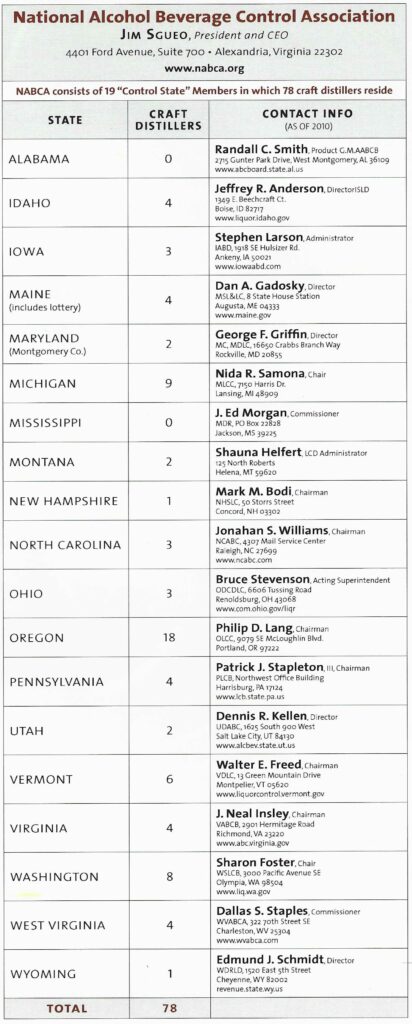There are many ways in which one can tell an enterprise has begun to succeed. Being invited to address the Board of Directors of NABCA, the National Alcohol Beverage Control Association, is one recognizable sign that Craft Distilling is showing up on Industry Radar.
In familiar parlance, NABCA represents the “Control States,” where the warehousing, wholesaling, and retailing of alcoholic beverages are run by the state. There are 19 control states in the U.S. and they are all, by and large, under pressure to privatize some or all of their operations. The pressure to privatize is a result of diminished state tax revenues. The idea of selling off lucrative distribution and/or retail programs to private companies holds out a tempting prospect of garnering much-needed cash. It is hardly within our purview to discuss the benefits or lack thereof of the Control State model; suffice it to say that it is a byproduct of the 21st Amendment that established the three-tier (supplier-wholesaler-retailer) system — thank you, Al Capone — created in 1937 as the nationwide organization representing the interests of alcoholic beverage control states. To its credit, NABCA takes its mission to protect the general public from illegal sales of alcohol, and the abuse of alcohol, very seriously.
The chair of each control state’s Alcoholic Beverage Commission (ABC) holds a position on the Board of Directors. Nearly all of these are political appointments made by state Governors, however, differing political points of view seem to have little or no bearing on NABCA activities or policies. Their collective job is to sell alcohol at a profit for the state transparently and in congruence with industry practices around the nation. To do so requires, as one Board Member allowed, “a lot of meetings.”
The meeting in question to which ADI was invited to provide a snapshot of craft distilling’s past growth and perceived future growth was held in January at the luxurious Naples Grande Hotel in Naples, Florida. (A quick perusal of neighboring real estate advertised in the glossy Naples Magazine on the bedside table indicated that, for anything between 1.6 and 13.6 million USD, I could snap up a beach-front condo or a less-than-modest pied-a-terre right on a canal.) We were allowed 20 minutes for our presentation, and given the quality of the questions that followed, it was obvious that more than mere polite interest was involved.
As NABCA President and CEO, Jim Sgueo noted in his introduction, the control states are very aware of what has happened and what is happening in craft brewing. And now craft distillers are appearing in droves, and their rather sudden appearance is causing certain concerns.
Most of these concerns are practical:
- Without reliable product profiles and reviews, how are they to know what to buy?
- Without regional sales histories, how are they to know how much to buy?
- With secure warehousing space at a very high premium, how are they to know how to plan inventory needs for the craft category?
- How can they be sure the craft-spirit products are good?. (“Good” also means in compliance with state and federal regulations.)
We tried to keep the answers simple and honest:
- Purchase what customers request. When in doubt, consider the medals awarded in responsible competitions to select brands.
- Buy in quantities that seem reasonable—craft spirits will tend to sell better in upscale and/or university- related markets than in blue-collar environments.
- If warehousing is an issue, try “on-demand” delivery. Let the supplier hold inventory on a pre-purchase basis, then deliver (and pay the excise tax) when the state asks for shipment.
- Compliance is one of ADI’s key educational missions. We can’t stop people from starting a distillery (and we don’t want to), but as a trade organization we can help them through the legalities and permitting processes.
There seemed to be little or no confusion between ADI and DISCUS (an ex-officio member of the NABCA Industry Steering Committee), and we stressed that, given there may be differences on some issues, we work as closely with DISCUS as we can.
The true measure of NABCA’s influence, however, can be seen in the aforementioned Industry Steering Committee. The Chairman is Mark Brown (Sazerac), Vice Chairman is John W. Byrne (Remy Cointreau USA). Other members are Bacardi USA, Beam Global Spirits & Wine, Brown-Forman, Constellation Spirits, Diageo North American, Heaven Hill Distilleries, Luxco, Moet Hennessy USA, Pernod Ricard USA, Sidney Frank Importing Co, and White Rock Distilleries. Needless to say, the top executives of these industry giants were present.
That ADI had been invited to address NABCA Directors and be a part of such august company was a distinct honor. But it was and remains an honor due not so much to ADI, but to the tremendous work of ADI member distillers. Indeed, there are many challenges ahead for craft distillers, but the recognition that NABCA has bestowed upon us augers well for the future of craft distilling.









